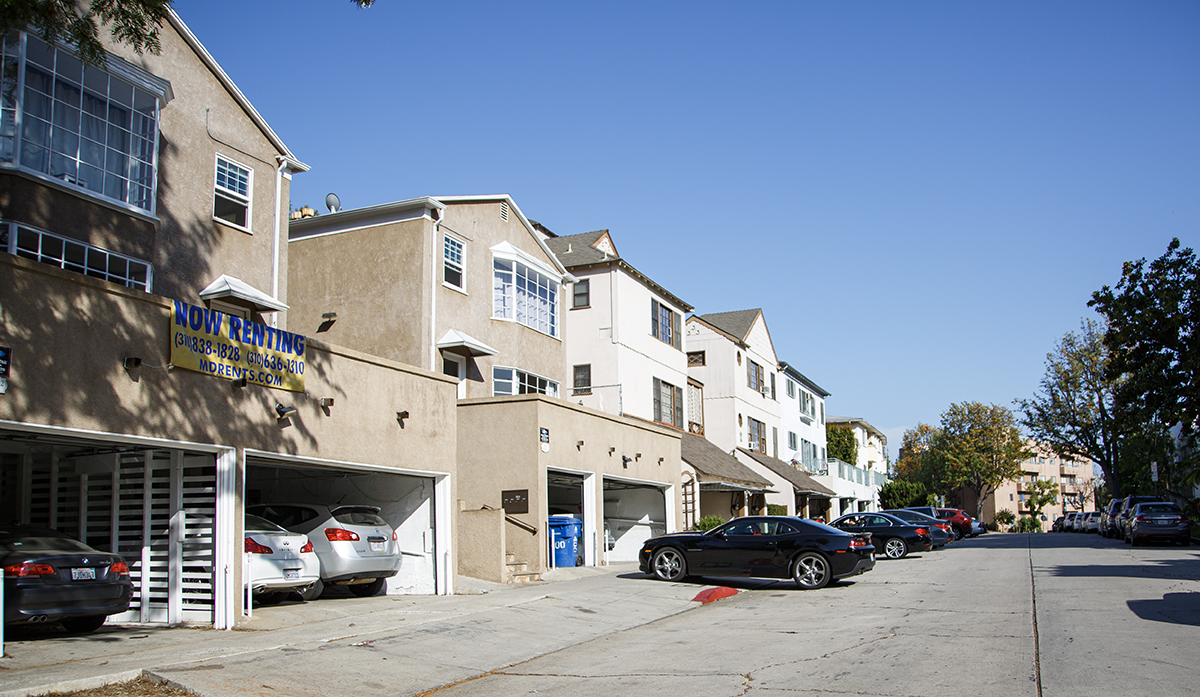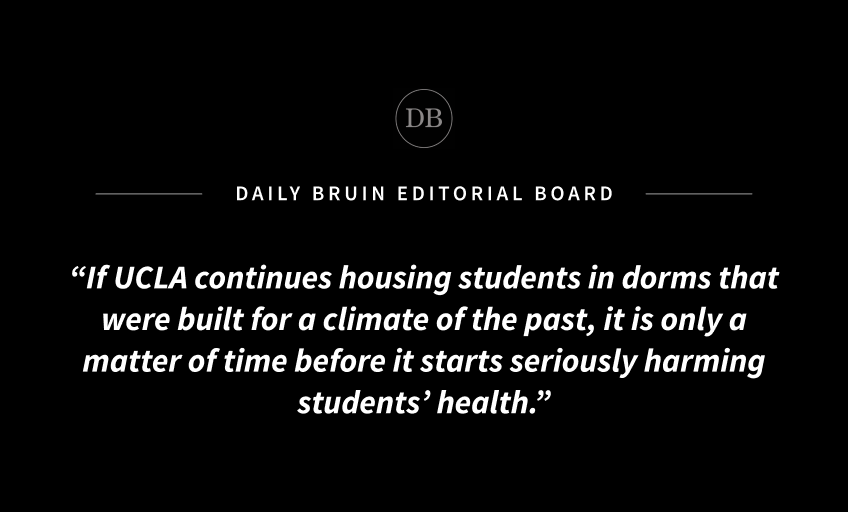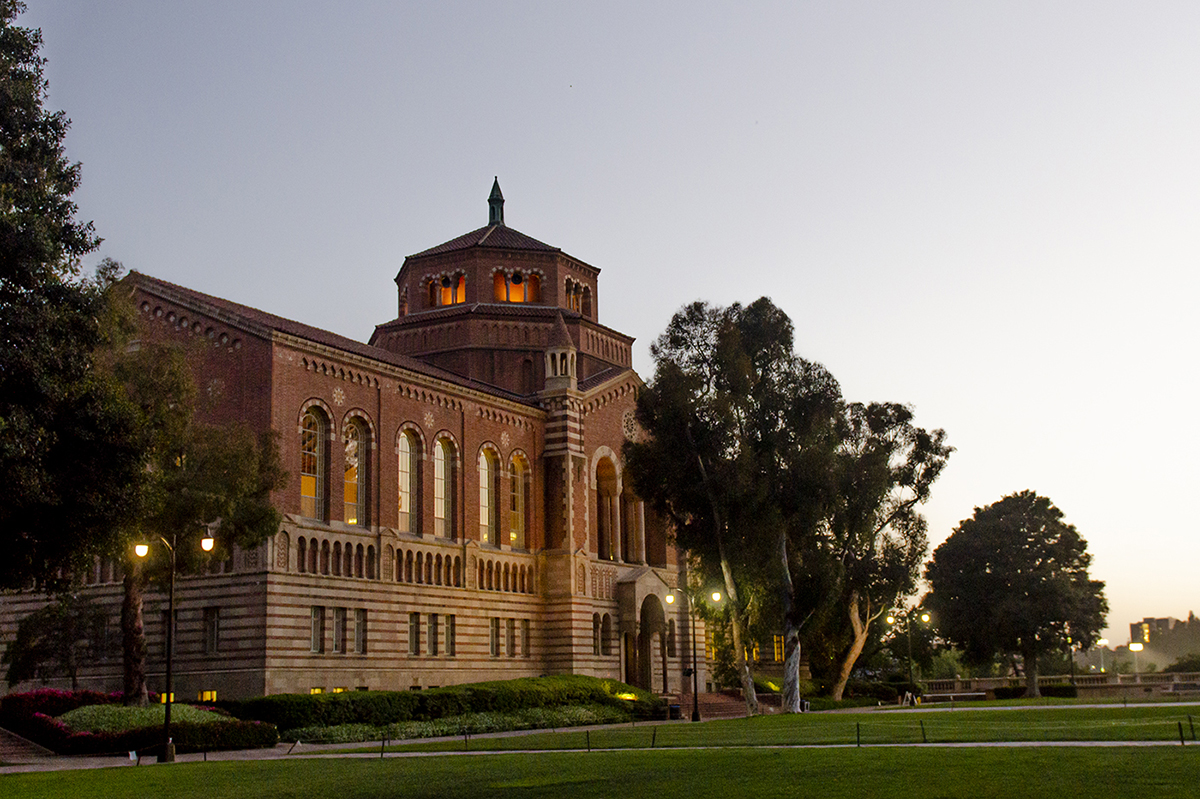Researchers warn of potential rise in extreme weather in Westwood

A rainy Royce Quad is pictured with hazy orange skies added to represent air from wildfires. Researchers said Westwood may see an increase in extreme weather conditions such as heavy rainfall and wildfires in the coming year. (Daily Bruin file photo. Photo Illustration by Ashley Ko/Illustrations director.)
By Myra Hussain
Sept. 24, 2023 1:27 p.m.
This post was updated Sept. 27 at 10:30 p.m.
The neighborhood of Westwood typically grants Bruins clear skies and warm weather, with warm months having an average daily high temperature of above 78 F in the next-door city of Beverly Hills and above 81 F in Los Angeles overall. However, following this year’s storms and torrential rains, researchers said UCLA’s home neighborhood could see an increase in extreme weather conditions.
According to a study from the Scripps Institution of Oceanography at UC San Diego, the likelihood of hazardous weather events in Southern California is growing.
Paul Stainier, a doctoral candidate at the UCLA Institute of the Environment and Sustainability, said tropical storms such as hurricanes or extreme weather conditions in LA will occur with heightened severity in the coming years, most likely because of climate change.
“We’ve seen increased intensity in fire seasons in the LA area, but also higher chances of really high rain events,” Stainier said.
Many Bruins witnessed recent weather events in Westwood, including Tropical Storm Hilary in August, which began as a hurricane off the western coast of Mexico and followed a northern trajectory into Southern California. Hilary arrived in Southern California on the same day as a 5.1 magnitude earthquake with an epicenter about 80 miles northwest of LA, leaving Bruins in Westwood to contend with the events simultaneously.
According to E&E News, human-induced climate change has most likely contributed in some way to Hurricane Hilary’s unusual path. Hilary’s impact on California resulted from rare weather circumstances that redirected the region’s easterly winds northward, guiding Hilary along the coast rather than rerouting it out to the ocean.
Additionally, back in February a winter storm brought low-elevation snow, rain and hail to LA County while also prompting a blizzard warning in the county’s mountainous regions for the first time in four decades.
Stainier said LA may continue to experience snowfall despite increasing temperatures.
“The LA area is likely to heat up on average, and so maybe snow becomes less likely,” Stainier said. “But also, these kind of complicated feedback loops between temperature and precipitation, how air is going to move in the LA basin, all of that might lead to increased individual snow events, even though it’s warmer overall.”
According to the Environmental Defense Fund, California’s climate has historically exhibited patterns of drought and rainfall cycles. However, human-induced climate change has heightened the intensity and severity of events such as wildfires during these cycles.
As per the National Integrated Drought Information System, California has witnessed 10 of its most significant wildfires within the last two decades, with five of them occurring in 2020.
Historically, wildfires near UCLA have reduced air quality and affected transportation routes. During the October 2019 Saddleridge fires, Bruins found it unsafe to go outside or keep their windows open. Additionally, following the Getty fire during the same month, UCLA canceled classes to ensure students’ safety.
Peggy Nguyen, a hazardous substance engineer at the CalEPA Department of Toxic Substances Control and doctoral candidate at the IoES, said the emergence of microclimates and changing ecosystems caused by climate change has contributed to the prevalence of wildfires in LA.
“As our climate shifts in the local area, the vegetation starts to shift to a vegetation type that’s more adapted to the new microclimate, and so what is already growing there becomes maladapted and weak,” Nguyen said. “They become subject to insect infestations and disease and as a result, in their weakened state, they can dry out and become fuel for the wildfires.”
Climate change can also affect the water supply in California, according to the United States Environmental Protection Agency.
Robert Reny, water resource data specialist for the Metropolitan Water District of Southern California and doctoral candidate at IoES, said the drought-prone weather in LA has decreased access to a clean water supply.
“In the past few years the two major important water supplies, the state’s water project and the Colorado River Project, or Colorado River Aqueduct, have both been hit by big droughts,” Reny said. “The previous three years were record low amounts of water supply for Southern California.”
While Southern California contends with lowering water levels, Bruins have experienced the effects of climate change recently through unprecedented levels of rainfall.
As reported by NBC Los Angeles, UCLA experienced 4.26 inches of rain during Tropical Storm Hilary. The deviation from normal rainfall in August was +3.48, according to the LA Almanac.
Additionally, in January Bruins found themselves walking to class with umbrellas and jackets as heavy rains struck Westwood and covered campus with large puddles. According to Yale Climate Connections, the storms were responsible for bringing power outages and 700 landslides within California.
Experts predict rainy conditions in Southern California this winter, as reported by the Sacramento Bee, but it is too soon to know exactly what this winter will look like.
The ongoing consequences of extreme weather conditions necessitate that individuals employ environmentally friendly practices and push for social change, said Madeleine Siegel, a doctoral candidate at IoES. Siegel said an increase in political activism is necessary to address climate change.
“One significant challenge is the lack of political momentum and the lack of political will to take action,” Siegel said. “We have that scientific understanding, but it’s really just the large-systems changes that are necessary and not quite happening yet.”
Siegel added UCLA can make its own efforts to address climate change by providing resources to students.
“Within UCLA, I’d say providing education and resources to give students opportunities to come together as communities to take action, and have more access to public transportation, is really important,” Siegel said.





